Veterinary extension professionals have to understand the complex conditions under which livestock farmers live and help them in getting their due share from the prices consumers pay by improving their voice in policy matters that are of concern to them, dissemination of appropriate technologies, effective and efficient delivery of livestock EASs, argue Dr SVN Rao and Dr PVK Sasidhar in this blog post.
CONTEXT
India has come a long way in increasing the production of milk, meat and eggs, and other livestock products between 2014-15 and 2021-22:
- 31 to 220.78 million tons of milk (51% growth);
- 69 to 8.80 million tons of meat (32% growth);
- 48 to 122.11 billion eggs (56% growth rate).
These achievements could be attributed to the efforts of millions of small and medium farmers, field veterinarians, researchers, input suppliers, extension advisory services (EAS) and several other stakeholders. But livestock farmers, especially smallholders, are finding it difficult to sustain their livelihoods through livestock alone. This is resulting in the younger generation losing interest in traditional livestock farming and many of them are switching to wage earning occupations, which is a serious cause of concern.
The reasons for these negative changes include:
- Falling income of producers and exploitation by intermediaries;
- Mismatch between farmers’ needs and research goals;
- Inability of the public sector EAS in addressing the needs of small and medium farmers;
- Unorganized market of livestock and livestock products;
- Weak bargaining power of livestock farmers, etc.
CHALLENGES VETERINARY EXTENSIONISTS FACE
India is experiencing several changes in its Animal Husbandry sector. These changes raise several new challenges for veterinary extension professionals. These include:
- Doubling the income of farmers;
- Multiple service providers and collaboration;
- From free service to paid services;
- Dairy co-operatives losing ground to private dairies;
- Shift from unorganized backyard poultry to organized commercial poultry;
- Milk procurement still unorganized;
- Shift in consumer preference from raw products to processed and packed products;
- Increased use of ICTs in delivery of EASs; and
- Increasing threats arising from animal disease outbreaks.
These aspects are discussed in detail below.
Doubling the Income of Farmers
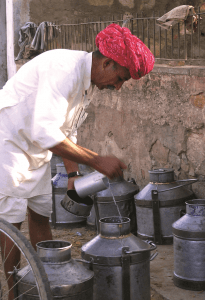 Many of the earlier policies focused primarily on increasing production outputs and improving food security through foods of animal origin. The policies did not clearly state the need to improve livestock farmers’ income simultaneously. To address this, in 2018 the Government of India (GOI), set a target of doubling farmers’ income by 2022, and bring farmers’ incomes on par with non-agricultural occupations’ income. The income of the farmers could be doubled by:
Many of the earlier policies focused primarily on increasing production outputs and improving food security through foods of animal origin. The policies did not clearly state the need to improve livestock farmers’ income simultaneously. To address this, in 2018 the Government of India (GOI), set a target of doubling farmers’ income by 2022, and bring farmers’ incomes on par with non-agricultural occupations’ income. The income of the farmers could be doubled by:
- Increasing production without concomitant increase in inputs;
- Increase the price of farmers’ produce keeping the input cost constant;
- Increase farmers’ share in the consumers’ price.
The last one is comparatively easy to achieve if the margin of the intermediaries is reduced through interventions. In the case of liquid milk, the producers’ share in the consumer’s price ranges between 45 to 60% which is comparatively better than in other livestock products (Box 1).
| Box. 1: Milk Procurement vis-à-vis Producer’s Share in Total Price* | ||||
| Commodity | Consumers Price for Toned Milk
(Rs.) |
Milk Procuring Company’s Earning (Rs.) | Producers Share
(Rs.) |
Percent of Producer’s Share in Company’s Earning |
| Milk / litres | 51 | 85.80 | 40 | 47% |
|
*Milk procurement price is determined not per litre, but according to per kg of Fat and SNF (Solids-Not-Fat) content of milk. As of January 2023, the maximum procurement price is Rs. 680/kg of Fat. It means if a farmer sells 100 kg buffalo milk with 6% Fat and >9 SNF, it will have 6 kg Fat which translates to Rs. 4080 or Rs. 40.80 per litre of liquid milk. However, the consumer’s price is Rs. 5100 per 100 litres. In addition, the milk procuring company sells 6 kg Fat@580/kg translating to Rs 3480. The total earning to company is Rs. 8580 per 100 liters or Rs. 85.80 per litre of milk procured. While the producer’s share is Rs. 40.80 per litre of milk produced. This is even lower in the case of cow’s milk as Fat and SNF levels are low. |
||||
Resource use efficiency/saving in cost of production as envisaged in GOI ambition of ‘Doubling the Farmers’ Income’ does not really benefit farmers always. There is the glaring example of Contract Poultry Farming (CPF) (see Box 2).
| Box 2: Does Saving in Cost of Production Result in Doubling Farmers’ Income?
Case of Contract Poultry Farming (CPF) Studies conducted by the authors revealed that the total cost of production per kg of live chicken produced under CPF was Rs. 55.50 with rearing charges of Rs. 4.00/kg of live chicken produced going to farmers. Including incentives, the net return to a contract farmer was Rs. 4.59/kg of live chicken produced, while the average farm gate live chicken price ranged from Rs. 65/kg to Rs. 90/kg in 2015. This showed that integrators made profits in the range of Rs. 10 to 35/kg of live chicken. Despite producing the chicken at a very low production cost, the total returns to farmers were significantly low because the efficiency surplus is largely taken in by contract companies and part of it passed on to consumers. In the overall value chain, the farmers were the last beneficiaries – after the companies and consumers – with a variable share of 13% to 40% from the consumer’s price. |
Another of those worst affected are the small ruminant farmers/pig farmers who are being exploited by the intermediaries who purchase the animals on approximate weight basis, and that too on credit. The farmer will not get more than 50% of the consumer’s price for rearing the animals for about one year. The market is totally controlled by middlemen and the livestock farmers have no say in the price set for their animals or their produce. The live animal markets (shandies) are totally unorganized and the brokers dominate the markets. Without increasing producer’s price it is almost impossible to double their income.
| Box 3: How to Help Farmers in Getting a Higher Share so as to Double Incomes
Challenge: The biggest challenge to EAS professionals is: How to help farmers get a higher share, so that their incomes are doubled. The milk procurement prices are based on a two-axis pricing policy i.e., based on fat and SNF content. These prices do not take into consideration the costs of feed and other inputs. Whenever milk procurement prices are increased input prices also go up and there is hardly any benefit to farmers. Instead, the milk procurement prices must be linked to the feed cost as is being followed in many developed nations. The milk-feed ratio indicates the amount of feed (in kg) the producer can buy by selling one litre of milk. This ratio should ideally be 1:1.5 – which means the producer can buy 1.5 kg of concentrate feed by selling one litre of milk. The prevailing ratios are less than 1:1.2 (calculated). The government must establish organized livestock and meat markets on cooperative lines to protect the interests of both livestock farmers and consumers. Similarly, the minimum support prices must be fixed for chicken under contract system. |
Multiple Service Providers
In the past, Veterinary EASs were being provided by Animal Husbandry Departments (AHDs) which was almost a monopoly service provider to livestock farmers. The focus of an AHD is to provide health care and breeding services to farmers free of cost. A stage has come that AHD is not able to provide quality EASs to millions of small herders whose demands vary depending upon the farming system in which they operate. Additionally, farmers are also not satisfied with the inaccessible and ineffective services provided (Rao and Natchimuthu 2019). As a result, several service providers have entered into the system to cater to the requirements of livestock farmers (Box 4).
| Box 4: Pluralistic EASs Providers in the Livestock Sector | |||
| Service provider | Inputs | Services | Comments |
| AHD | Semen, medicines, vaccines, fodder seeds | Free breeding and health care services | Monopoly in the past |
| Dairy Corporations | Cattle feed | Milk / milk products marketing | Milk production enhancement programmes |
| Milk Cooperatives (1970) | Semen, medicines, vaccines, cattle feed, fodder seeds |
Marketing, EASs, Breeding, Health care (paid services) |
Milk procurement, processing and marketing;
Discontinued services |
| Producer Companies |
Semen, medicines, vaccines, cattle feed, fodder seeds |
Dairy unions were converted into dairy companies / FPOs | |
| NGOs (BAIF, JK Trust, etc.) | Extension advisory Breeding, Health care (paid services) | Considered as effective in delivery of services | |
| KVKs (1975) | Fodder seeds | EASs (free) | OFTs and trainings;
Few Animal Science SMS |
| Poultry Integrators | Chicks, feed, vaccines, medicines | EASs and marketing | Farmers are paid rearing charges |
| FPOs (2020) | Credit | Production input services | Capacity building of members |
| Cooperative banks | Credit | – | Many are financially sick
|
| NABARD/ Lead banks | Credit for projects | Finance capacity building and trainings | Promoting FPOs |
Why is there a need for collaboration among stakeholders for livestock development?
The target of all service providers is the livestock farmer. But each differs in their mandates, motives, approaches, capabilities, resources, etc. Collaboration among them is a must for the following reasons:
- Farmers’ problems are complex and calls for multiple inputs;
- Helps in saving scanty resources by avoiding duplication;
- Produces synergistic effect– – by complementing each other;
- Sharing of information – helps in joint planning and implementation;
- Win-Win situation for all collaborating agencies.
|
Box 5: Inadequate Collaboration among Various Service Providers Challenge: How to achieve effective collaboration among various service providers in efficient use of scarce resources for effective delivery of EAS. This can be achieved mainly by maintaining good relations with all the service providers, establishing multi-stakeholder platforms, organizing regular coordination meetings, sharing resources and working together for a unified goal, namely, farmers’ well-being. The present authors have suggested institutional mechanisms to promote better interaction, knowledge flows, and collaboration between important stakeholders for effective veterinary service delivery (See Rao et al. 2015). |
 From Free Service to Paid Services
From Free Service to Paid Services
In the past most of the EASs were provided by public sector institutions, such as AHDs on subsidy/free of cost. The farmers have no choice to either choose a service provider or demand quality services. Since the early 1990s the public sector monopoly came under increasing threat as many started questioning its economic merit and efficiency. For example, the AHDs of Gujarat, Himachal Pradesh, Haryana, Maharashtra, UP, Tamil Nadu and Andhra Pradesh had spent 50 to 60% of their budget on administration (Ravikumar 2005). There is robust evidence that livestock farmers were not convinced with the services provided by the public sector and they are willing to pay for effective and timely services in Andhra Pradesh (Badhulal 1999; Jagadeeswary 2003; Ravikumar et.al. 2006; Ahuja et.al. 2008), Bihar (Kumar and Rao 1999), Gujarat (Ahuja, et.al. 2000), Karnataka (Channappa Gouda 2009), Kerala (Ahuja, et.al. 2000), Rajasthan (Ahuja, et.al. 2000; Rajput 2006), Sikkim (Rao 2002), Tamil Nadu (Rajashree 2000; Kumar 2006), Uttar Pradesh (Chander et.al. 2006) and West Bengal (Sen and Chander 2003a). The options suggested were decentralization, cost sharing, cost recovery, withdrawal from selected services and PPP.
In India there is a mismatch between farmers’ needs, and research areas taken up by researchers. For example, researchers focus on cloning, sexed semen, etc., (high tech research which help the researchers to get their research output published in high impact journals) instead of focusing on reducing the incidence of repeat breeding in bovines, and prevention and control of mastitis, the two main ailments because of which dairy farmers are incurring heavy losses every year. It is in the realm of anybody’s wisdom that these two ailments if not treated successfully make the animals unproductive, and finally land them in slaughterhouses.
Unless farmers occupy the centre stage by sharing the cost of services, there is little scope for them to demand need-based research and quality services (Box 6).
|
Box 6: Farmers’ Willingness to Pay vs. Quality of Services Challenge: How to motivate the livestock owners to share the cost of services Today Artificial Insemination services are being provided by AHDs, dairy cooperatives, private practitioners, NGOs, etc., on payment. Similarly, poultry farmers have a choice to choose the integrator with whom they can enter into a contract or dairy farmers have options to sell the surplus milk to a vendor, or collection centers operated by three or four dairy plants within the same village. Livestock farmers will also have a say in demanding the quality of services when they share the cost of the service. Another advantage is that there is scope to improve the quality of services when there is positive competition. Demand-driven paid services also have the disadvantage of service providers paying attention mostly to resource-rich farmers but poor farmers have to bear the financial burden. Privatization of EAS was started in European countries in the early 1990s and later many livestock developed countries followed suit. They have demonstrated that it is advantageous for farmers to share the cost of services, including EASs, and also finance the research. This has resulted not only in improvement in the quality of services but also in farmer-oriented research (Sulaiman and Sadamate 2000). Farmers must be made aware of the advantages of demand-driven EAS as compared to supply-driven services, because it will i) enhance their capacity to demand quality services; ii) make the service provider accountable to the farmer; and iii) give them a choice to select the service provider (Balamatti 2017). Private service providers may not be much interested in working in remote areas because it may not be cost effective for them. In such instances, the public sector service providers must come forward to provide technical inputs at reasonable prices and EASs free of cost. It is always a challenge for public sector EASs to reach the unreached. Therefore, farmers must be encouraged to form farmers’ organizations to demand quality services and seek effective technological solutions for their problems. |
Dairy Cooperatives Losing Ground to Private Dairies
Dairy cooperatives, until recently touted as harbingers for socio-economic change among dairy farmers, especially smallholders, are now on the verge of collapse. Except in Gujarat and to some extent in Karnataka, dairy cooperatives paved the way for the growth of private dairies. Now, the volume of milk procured by private dairies is more than that of dairy cooperatives. Private dairies procured about 560 lakh kg per day compared to 540 lakh kg per day by cooperative dairies in 2020-21 (CRISIL 2021). Damodaran had clearly predicted in 2017 that private dairies would overtake cooperative dairies by 2020 (Harish Damodaran 2017).
There are several reasons for the failure of dairy cooperatives in India (Rao 2019):
- Private dairies – such as Godrej Jersey Dairy (Jersey), Hatsun Agro product Limited (HAP), Nestle – are well entrenched in processing and marketing a variety of products in addition to producing cattle feed;
- Due to political reasons some of the cooperative dairies were converted into milk producer companies;
- NDDB is promoting producer companies in different states of India;
- As suggested by the Alagh Committee, the GOI has come out with hybrid models of Co-ops. and private institutions, as an alternative to Co-ops. The objective of this hybrid model of Farmer Producer Organization (FPO) is to increase farmers’ income;
- FPOs are conceived in order to facilitate farmers’ participation in marketing, help in eliminating intermediaries in marketing, provide better bargaining power with input suppliers and bulk purchasers, and improve the farmers’ access to technology, inputs, value addition and services. The FPOs are yet to prove their worth.
Now there are several methods of milk procurement, and the producer has an option to choose depending upon the situation. Similarly, consumers also have options to choose, namely, i) dairy co-ops; ii) private dairies; iii) vendors; iv) Milker-vendor; v) direct to consumers, etc. The milk procurement prices vary from Rs. 25 to Rs. 60 and sale prices vary from Rs. 42 to Rs. 90 depending upon the species (crossbred cow, desi cow, buffalo), quality of milk (fat and SNF percentage), presentation (raw or pasteurized milk; loose or packed, etc.) and delivery point (milk booth or door delivery).
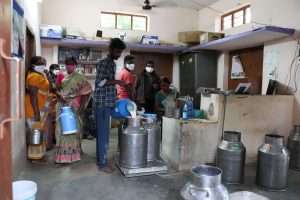 A study on the impact of the milk incentive scheme being implemented by AHD-Karnataka reported that the milk procured by the rural dairy farmers increased from 11% to 39% in a span of seven years through implementation of the Milk Incentive Scheme. This scheme envisaged giving an incentive of Rs. 2 per liter of milk supplied by dairy farmers to the milk cooperative societies. This increase was attributed to the gradual shift of rural dairy farmers from private milk collection centres to milk cooperative societies (DAHVS 2020).
A study on the impact of the milk incentive scheme being implemented by AHD-Karnataka reported that the milk procured by the rural dairy farmers increased from 11% to 39% in a span of seven years through implementation of the Milk Incentive Scheme. This scheme envisaged giving an incentive of Rs. 2 per liter of milk supplied by dairy farmers to the milk cooperative societies. This increase was attributed to the gradual shift of rural dairy farmers from private milk collection centres to milk cooperative societies (DAHVS 2020).
|
Box 7: Dairy Cooperatives or Private Dairies Challenge: Is it necessary to sustain dairy co-ops or encourage privatization? Unless the dairy co-ops are able to successfully compete with the private dairies, it is difficult for them to survive. The dairy co-ops are established basically to help both the milk producers in collecting milk regularly and consumers in selling the milk and milk products at reasonable prices. They are losing their market share to private dairies. This could be attributed to the inability of the dairy co-ops to adhere to cooperative principles, large scale corruption, mismanagement of co-ops, and interference from the concerned state governments. |
Shift from Unorganized Backyard Poultry to Organized Commercial Poultry
Today, with commercialization of the poultry sector, more than 80% of India’s poultry output is contributed by organized commercial farms. The farmers engaged in backyard poultry farming have also come down to about 30 million (19th Livestock Census). Five major players – Suguna in Coimbatore, Venky’s in Pune, CP, Sneha, and Shalimar in Kolkata – constitute 60% of the broiler meat market (DAHDF 2016).
The chicken and egg prices are set by the Pune-based NECC (National Egg Coordination Committee) on a daily basis, which is accessible to all through mass media (print and digital). At present integrators, having come a long way, are ruling the roost in production, processing and marketing of chicken. It is estimated that about 70% of the poultry population (215 million layers and 480 million broilers) is being reared by small and medium farmers under the contract farming system. Although integrators are seen as exploiters of small and medium farmers (Thamizhselvi and Rao 2010; Sasidhar and Suvedi 2015), they are successful in enhancing their market share mainly because of the provision of integrated inputs, EASs, and marketing services to the contract farmers.
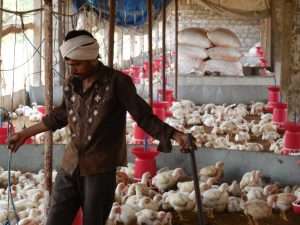 The farmers are to a great extent free from production and marketing risks. The integrators also have the biggest advantage of holding lakhs of birds that are reared by millions of farmers in different locations, thus freeing them from the risk of losing entire flock(s) due to disease outbreaks if all the birds are reared in one or two locations. The total backyard poultry population has also increased by 45.8% from 2012 to 2019, indicating a positive trend in the growth of backyard poultry. This could be attributed to the release of several crosses of improved poultry for backyard rearing (Vanaraja, Giriraja, Gramapriya, Chabro, CARI Gold, Swarnadhara, Kalinga Brown, Nandanam, Rajasri, etc.) and encouraging the BPL families to rear these birds through implementation of Rural Backyard Poultry Development under the National Livestock Mission of the GoI.
The farmers are to a great extent free from production and marketing risks. The integrators also have the biggest advantage of holding lakhs of birds that are reared by millions of farmers in different locations, thus freeing them from the risk of losing entire flock(s) due to disease outbreaks if all the birds are reared in one or two locations. The total backyard poultry population has also increased by 45.8% from 2012 to 2019, indicating a positive trend in the growth of backyard poultry. This could be attributed to the release of several crosses of improved poultry for backyard rearing (Vanaraja, Giriraja, Gramapriya, Chabro, CARI Gold, Swarnadhara, Kalinga Brown, Nandanam, Rajasri, etc.) and encouraging the BPL families to rear these birds through implementation of Rural Backyard Poultry Development under the National Livestock Mission of the GoI.
|
Box 8: How to Promote Backyard Poultry for Supplementary Income for the Resource Poor Challenge: How to promote backyard poultry which is considered as a supplementary income source for resource poor families. It is of paramount importance to encourage backyard poultry as it provides supplementary income and animal protein to BPL families. Instead of supplying 4- to 6-week old birds to BPL families, it is worth supplying day-old chicks which help the families develop affinity for the birds, so farmers hesitate to sell or slaughter the birds. They rear the birds till the completion of the egg laying cycle which is necessary for exploiting the full benefit of these wonderful strains (Rajalakshmi et al. 2015). The EASs providers must impart necessary skills on brooding, feeding, etc., and other services to the beneficiaries. It is also equally important to encourage rearing of desi chicks, especially in those areas where veterinary services are not readily accessible. |
Milk Procurement Still Unorganized
Despite a vast network of organized dairies, milk procurement is still in the hands of the unorganized sector. Vendors are still holding the ground despite being seen as exploiters of both milk producers and consumers. The well-known reasons are that they collect milk from producers’ doorsteps and deliver milk at consumers’ doorsteps in addition to providing services such as credit, milking the animals, information on animal management, etc., to the producers. The importance of this informal milk sector in India was very well highlighted by Joseph et al. (2011).
|
Box 9: Elimination of Milk Vendors from the Dairy Business Challenge: What to do to eliminate milk vendors from the dairy business When it is not possible to eliminate the milk vendors in dairying the best way is to train the vendors on hygienic milk collection and transportation to the consumers, which will help the consumers to get good quality milk. It is also better to train them in management of dairy animals and use them as key information providers to the producers. |
Shift in Consumer Preference from Raw Products to Processed and Packed Products
Although it is unsafe to purchase products in raw form rather than as hygienically processed and packed products, more than 80% of consumers purchase raw milk (instead of pasteurized and packed) and live broilers and wet meat (instead of packed products). The consumers have to pay more for the packed products when compared to raw products. Because of this milk vendors, roadside butchers or meat shop owners survive as they sell only raw milk and live broilers or wet meat.
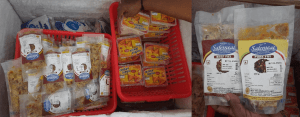 The live broiler meat market still constitutes more than 90-95% of total volume of sales against 5% of the processed chicken meat segment. Realizing the increase in demand for fresh meat products, companies like Freshtohome, Licious, TenderCuts, Zappfresh, Fipola, etc., were established with a vision to provide quality meat to their consumers. These companies claim to be supplying hygienically processed meat and meat products and varieties of fish to the consumers through various marketing channels.
The live broiler meat market still constitutes more than 90-95% of total volume of sales against 5% of the processed chicken meat segment. Realizing the increase in demand for fresh meat products, companies like Freshtohome, Licious, TenderCuts, Zappfresh, Fipola, etc., were established with a vision to provide quality meat to their consumers. These companies claim to be supplying hygienically processed meat and meat products and varieties of fish to the consumers through various marketing channels.
|
Box 10: Raw Products to Processed and Packed Products Challenge: How to encourage consumers to go for hygienically processed products? The GOI stipulated several standards, regulations, and guidelines to produce and market livestock products. But compliance to standards is not enforced or monitored in a desirable manner. All the stakeholders are to be blamed for the production, processing and marketing of poor-quality livestock products (Rao and Sasidhar 2022). The GOI has come up with a scheme to provide assistance for modernization of slaughterhouses and carcass utilization plants, but the response is poor. The GOI must insist that municipality-owned slaughterhouses be modernized so that their slaughterhouses provide hygienically processed meat to consumers and mitigate the problem of pollution of land, water, and air. The veterinary extension professionals have an important role to play in organizing consumer awareness campaigns that will enable them to understand the importance of consuming quality products. The establishment of modern meat shops must be promoted. The animal science institutions (ICAR institutes, Veterinary Colleges, Dairy Science Colleges, and Fishery Science Colleges) must be encouraged to process and sell their farm produce through their respective sales counters. The consumers’ preference to purchase products from these sales counters need to be exploited. When it is not possible to shut down the roadside slaughterhouses, a big source of pollution, it is necessary to train the butchers in hygienic slaughter of animals and proper disposal of slaughterhouse waste. |
Increased Use of ICTs in Delivery of EASs
ICTs were handy for reaching livestock farmers during the COVID-19 pandemic. The biggest advantage is that almost all the farmers own mobile phones. Many extension professionals could effectively deliver information pertaining to animal health, management and marketing of livestock products through this medium.
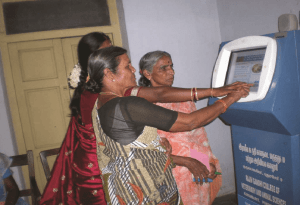
|
Box 11: ICTs in Delivery of EASs Challenge: How to exploit the potential of ICTs in transfer of information The potential of the ICTs in communicating to several million livestock owners is yet to be realized as the tall claims made by several project leaders on the use of ICTS on sustainability, scalability and impact of several ICT projects are doubtful. Blum et al. (2020) recommended research to: i) study and understand the developmental and empowerment implications of ICTs; ii) assess the contribution of ICTs in agriculture and rural development; and iii) study its contribution in empowering the rural poor. Chander et al. (2020) presented the ways and means to support livestock and poultry farmers during pandemics. Shaik (2020) believed that EAS must acquire and implement digital tools for a truly modern, farmer-centric, retail-like operating model that integrates available and emerging digital technologies to meet and exceed expectations of the agriculture sector. Based on their experience with using YouTube in effectively providing advice to livestock farmers on preventive measures during Gaja cyclone in the southern districts of Tamil Nadu and COVID-19 lockdown period, Tamizhkumaran and Saravanan Raj (2020) suggested that EAS providers should take up this platform to transfer knowledge to a larger audience. Veterinarians, institutions, NGOs and extension agencies from all the states need to take up ICT initiatives in local languages to give wider coverage. If this initiative is started after conducting a need-based analysis it will become more effective. |
Increasing Threats from Animal Disease Outbreaks
Livestock are under constant threat from various diseases and some of them are of zoonotic importance. Now India is witnessing outbreaks of African swine fever and Lumpy Skin Disease that are playing havoc in several states causing deaths of thousands of pigs and cattle. The cases of classical swine fever in human beings are also reported. These are in addition to the already existing diseases of zoonotic significance, such as TB, Rabies, Anthrax, Brucellosis, Toxoplasmosis, Japanese Encephalitis, Leptospirosis, etc.
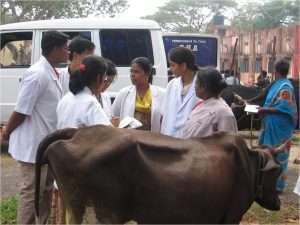
All these happen due to lack of awareness about good animal husbandry practices, poor waste management practices, and weak food safety enforcement that contribute to disease outbreaks, causing significant economic losses.
|
Box 12: Control and Prevent Diseases and adopt Integrated One Health Challenge: How to control and prevent these diseases and establish integrated One Health India is not able to eliminate most of these diseases due to poor adoption of good livestock management practices, poor hygienic conditions, and lack of political will to strictly enforce public health measures. One Health is an integrated, unifying approach that aims to sustainably balance and optimize the health of people, animals and ecosystems. It recognizes that the health of humans, domestic and wild animals, plants, and the wider environment (including ecosystems) are closely linked and interdependent. It is a big challenge for the veterinary extension professionals to adopt the One Health approach to prevent and control these diseases. Thakur and Gupta (2022) dealt at length about the lessons the veterinary extension professionals must learn to reduce the impact of such diseases on the livelihoods of livestock farmers. Therefore, the One Health approach and close collaboration between human and animal health professionals is recommended by the World Health Organization and the World Organization for Animal Health. |
CONCLUSIONS
In general, the world is experiencing sea changes in delivery of EAS and these include:
- Provision of EASs by a single public sector organization to multiple EASs providers with multiple funding sources;
- Standard one-size-fits-all model to country-specific models;
- Centralized to decentralized public-private partnerships;
- Focus on technology and enhancing production to address a wide range of problems, viz., natural resource management, marketing, adaptation to climate change, nutrition etc. (Blum et al. 2020).
Many of these changes impact the veterinary extension sector too. Veterinary extension professionals have to understand the complex situation of livestock farmers, positive global changes in delivery of EASs, and how best to use these experiences in helping livestock farmers. It is high time that extension professionals understood their varied roles and improved their capacity to address challenges effectively. Even though production of livestock products is increasing steadily, India is struggling to meet the expected targets fixed for 2023. Although the per capita availability of milk is more than the required quantity, it is unfortunate that about 20 to 25% of people below the poverty line cannot afford to drink milk. Similarly, some dairy cooperatives and many of the private dairies and milk producer companies are reaping profits, but the milk producers especially the smallholders are finding it difficult to sustain their livelihoods. The poultry integrators who dominate the chicken and egg production field are doing good business, but contract farming is considered as exploitative of the farmers. The plight of the small ruminant owners and pig farmers is much worse as the marketing is mostly unorganized and exploited by the intermediaries. So, veterinary extension professionals must help livestock farmers get their due share from the consumers’ prices by addressing these issues.
REFERENCES
Ahuja V, George PS, Sunil Ray, McConnell KE, Kurup MPG, Gandhi V, Dina Umali D and De Haan. 2000. Agricultural services and the poor: Case of livestock health and breeding services in India. Ahmedabad: IIM.
Ahuja V, Kurup MPG, Bhasin NR and Joseph AK. 2008. Assessment and reflections on livestock service delivery systems in Andhra Pradesh. Proceedings of the workshops and consultations held at Mahbubnagar, Chittoor, Annavaram, Nalgonda and Rampachodavaram. www.intercooperation.org.in/km/livestock
Ahuja V, McConnell KE, Umali-Deininger D and de Haan C. 2008. Are the poor willing to pay for livestock services? Evidence from rural India. Indian Journal of Agricultural Economics 58(1):84-89.
Balamatti Arun. 2017. Demand-driven extension: Need for public extension to turnaround. Blog 65, Agricultural Extension in South Asia (AESA).
Blum ML, Cofini F and Sulaiman RV. 2020. Agricultural extension in transition worldwide: Policies and strategies for reform. Rome: FAO. https://doi.org/10.4060/ca8199en
Badhulal B. 1999. An analysis of dairy farming practices among the tribal farmers of Khammam district of Andhra Pradesh. MVSc. Thesis (Unpub.). Hyderabad: Acharya NG Ranga Agricultural University.
Chander M, Singh BP, Arya HPS, Mandape MK and Ravikumar S. 2006. Status of government run veterinary services in Uttar Pradesh: A case of Bareilly district. Indian Journal of Field Veterinarians 2(1):61-65.
Chander Mahesh, Kannadhasan MS and Raj Kumar Patel. 2020. COVID-19: How EAS can support livestock and poultry farmers during lockdown. Blog 117, Agricultural Extension in South Asia (AESA).
Channappa Gouda B. 2009. Evaluation of livestock service delivery by different agencies in Karnataka. MVSc. Thesis (Unpub.). Izatnagar, India: Indian Veterinary Research Institute.
CRISIL. 2021. CRISIL research data on milk procurement by dairy companies in India. https://www.aninews.in/news/business/business/crisil-research-data-on-milk-procurement-by-dairy-companies-in-india20211006182012/.
DAHVS. 2020. Evaluation of milk incentive scheme. Bengaluru: Department of AH & VS, Karnataka. https://kmea.karnataka.gov.in/storage/pdf-files/Reports%20and%20other%20docs/Evaluation%20of%20Milk%20Incentive%20Scheme%20-%20Executive%20Summary%20&%20Findings%20&%20Recommendation.pdf
Damodaran Harish. 2017. Private dairies to surge ahead of cooperatives in milk procurement by the decade-end. Indian Express, January 12, 2017. https://indianexpress.com/article/india/private-dairies-to-surge-ahead-of-cooperatives-in-milk-
Government of India. 2016. National action plan for egg and poultry-2022 for doubling farmers’ income by 2022. New Delhi: Department of Animal Husbandry, Dairying & Fisheries, Ministry of Agriculture & Farmers Welfare. (https://www.google.com/search?q=national+action+plan+for+poultry+2020+india&rlz=1C1GCEB_enIN951IN951&oq=national+action+plan+for+poultry+2020+india&aqs=chrome..69i57.13264j0j7&sourceid=chrome&ie=UTF-8).
Government of India. 2019. Basic Animal Husbandry Statistics. 2019. New Delhi: Ministry of Agriculture, Department of Animal Husbandry and Dairying, Krishi Bhawan.
Thakur Devesh and Gupta Atul. 2022. Dealing with lumpy skin disease: Lessons for the future. Blog 187, Agricultural Extension in South Asia (AESA).
Jagadeeswary V. 2003. Establishing the private veterinary clinics in Andhra Pradesh – An opinion study. MVSc. Thesis (Unpub.). Hyderabad: Acharya NG Ranga Agricultural University.
Joseph AK, Raghunathan N and Kulkarni S. 2011. The importance of the informal milk sector in India. Paper presented at the ILRI workshop on ‘Safety of animal source foods with an emphasis on informal sectors’. New Delhi, 8 February, 2011. https://www.slideshare.net/ILRI/foodsafety-joseph Accessed on 15 January 2023.
Kumar KS. 2006. Livestock services delivery by private agencies – A case study in Tamil Nadu. MVSc. Thesis (Unpub.). Izatnagar, Indian Veterinary Research Institute.
Kumar S and Rao SVN. 1999. Awareness and utilization of dairy production inputs and services by the farmers of Bihar. Pages 155-157 in: Rural India
Rajalakshmi M, Rao SVN, Natchimuthu K, Venugopal S and Kumar R. 2015. Impact of rearing improved backyard poultry on the rural households in Puducherry. Indian Journal of Poultry Science 50(1):96-103.
Rajalakshmi M, Rao SVN, Natchimuthu K, Venugopal S and Kumar R. 2015. Impact of Rearing-Improved Backyard Poultry on the Rural Households in Puducherry. Indian Journal of Poultry Science 50(1): 96–103.
Rajashree. 2000. Farmers perception on privatizing animal husbandry extension services. MVSc. Thesis (Unpub.). Chennai: TANUVAS.
Rajput DS. 2006. Animal health delivery system among pastoralists in arid zone of Rajasthan. PhD Thesis (Unpub.). Izatnagar, : Indian Veterinary Research Institute
Rao CK. 2002. Availability of medicines and veterinary services in Sikkim. Pages 87-92 in Livestock services and poor. Bhubaneshwar, India: Proceedings of the International Workshop..
Rao SVN. 2013. Why collaboration matters for livestock development? Blog 6, Agricultural Extension in South Asia (AESA).
Rao SVN. 2019. Dairy cooperatives at the crossroads. Blog 122, Agricultural Extension in South Asia (AESA).
Rao SVN and Natchimuthu K. 2019. Inefficient extension services: Livestock owners bear the brunt. Pages 403-406 in Taking stock and shaping the future: Conversations on extension (Sulaiman VR, Onima VT, Nimisha Mittal and Athira E. eds.). Hyderabad: Agricultural Extension in South Asia (AESA).
Rao SVN and Sasidhar PVK. 2020. Revamping veterinary and animal husbandry extension in India. Blog 126, Agricultural Extension in South Asia (AESA).
Rao SVN and Sasidhar PVK. 2022. Marketing of livestock products – does quality and health of consumers really matter? Blog 111, Agricultural Extension in South Asia (AESA).
Rao SVN, Sulaiman VR, Natchimuthu K, Ramkumar S and Sasidhar PVK. 2015. Improving the delivery of veterinary services in India. Rev. Sci. Tech. Off. Int. Epiz. 34(3):122-129.
Ravikumar RK. 2005. Livestock extension activities under state department of animal husbandry in India – An institutional analysis. PhD Thesis (Unpub.). Izatnagar, Indian Veterinary Research Institute
Ravikumar S, Chander M and Rao BS. 2006. Option for privatized delivery of veterinary services in India: A farmers’ perspective at micro level in Andhra Pradesh. Beijing: International Conference on Livestock Services, 17-19 April 2006.
Sasidhar PVK and Suvedi Murari. 2015. Integrated contract broiler farming: An evaluation case study in India. Modernizing Extension and Advisory Services. www.meas.illinois.edu
Sen A and Chander M. 2003. Perceived constraints to private veterinary practice in India. Preventive Veterinary Medicine 60:143-154.
Shaik N Meera. 2020. Is COVID crisis a tipping point for transformational changes in digital extension? Blog 125, Agricultural Extension in South Asia (AESA).
Sulaiman VR and Sadamate VV. 2000. Privatizing agricultural extension in India. New Delhi: Policy Paper 10, National Centre for Agricultural Economics and Policy Research.
Tamizhkumaran and Saravanan Raj. 2020. YouTube – An effective tool for extension and advisory services. Good Practices Note, Agricultural Extension in South Asia (AESA).
Thamizhselvi RK and Rao SVN. 2010. Is contract broiler farming exploitative to small farmers? Indian Journal of Animal Sciences 80(12):1243-1250.
 Dr SVN Rao, Professor and Head (Retd.), Department of Veterinary and Animal Husbandry Extension Education, Rajiv Gandhi Institute of Veterinary Education and Research (RIVER), Puducherry. He can be contacted at: svnrao1953@gmail.com / Mob: 9443007506.
Dr SVN Rao, Professor and Head (Retd.), Department of Veterinary and Animal Husbandry Extension Education, Rajiv Gandhi Institute of Veterinary Education and Research (RIVER), Puducherry. He can be contacted at: svnrao1953@gmail.com / Mob: 9443007506.
Dr , PVK Sasidhar, Professor, School of Extension and Development Studies, Indira Gandhi National Open University (IGNOU), New Delhi. He can be contacted at: pvksasidhar@ignou.ac.in / Mob: 9910050413.
, PVK Sasidhar, Professor, School of Extension and Development Studies, Indira Gandhi National Open University (IGNOU), New Delhi. He can be contacted at: pvksasidhar@ignou.ac.in / Mob: 9910050413.

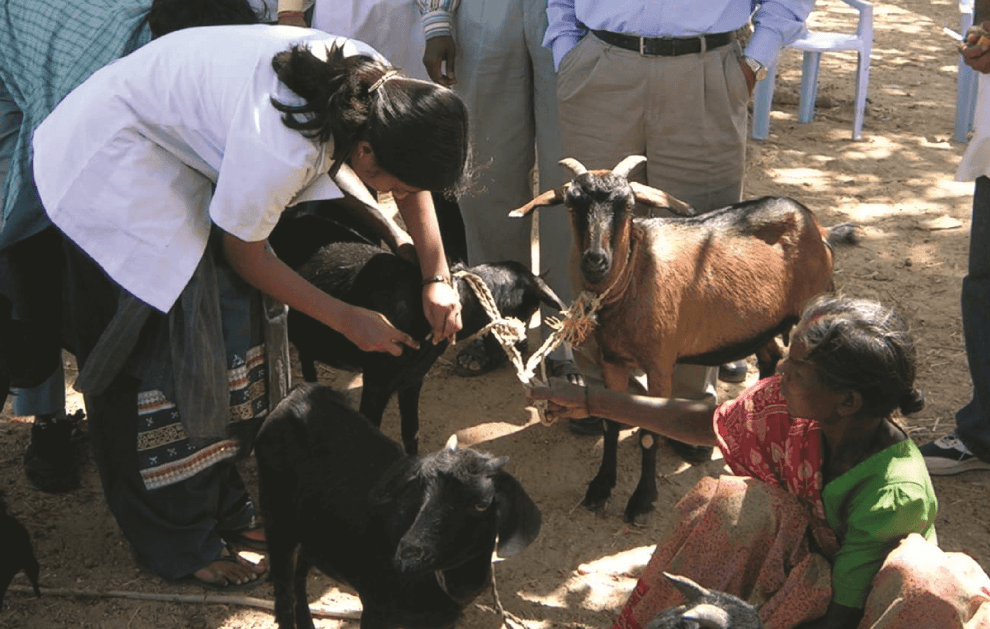

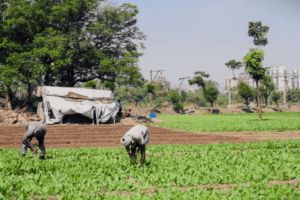

“Many thanks for the Blog 189 on ‘Challenges for Vety. Extension’ by SVN Rao and PVK Sashidhar, two very experienced and knowledgeable extensionists in the livestock sector. I find the Blog very informative – a good attempt to cover some crucial aspects of EAS related to this complex sector.
Since the authors are good friends of mine I take the liberty of stating that there are some developments/trends that have emerged since the last few years that are worth considering as these would influence the production systems, marketing systems, economics of livestock keeping and hence the EAS systems also.. However, I admit I have limited access to literature and maybe someone has already analysed these aspects.
1. Milk of cows of Indigenous breeds being sold at high price (Rs.80 to 100/lit.) in many cities of Western and Central states and maybe other states as well..While at that price the economics of milk production will change but there is need to study whether small holders are also benefiting from this trend and if not consider ways of extending benefit to them through desired approach of EAS.
2. Use of Dung as Organic Manure / Vermicompost – Dung is not considered a waste product any more and fetches high price probably due to deteriorating soil condition and stress on Natural / Organic Farming (some claim that dung and urine can provide enough income to maintain dry cows). However, there is a need to study the above mentioned aspects for proper understanding based on facts and train extension workers so that smallholder producers can benefit.
3. Marketing of Livestock and livestock products – While the authors have rightly pointed out that smallholder producers are facing difficulties in marketing and not getting good price for the products/animals – I came across reports of some initiatives/approaches aimed at extending benefits to small holders.
3.1 NGOs – while the BAIF has developed Producer Organisations at a few places in their area of operation a Lucknow based NGO – Goat Trust is organising groups of Goat keepers and helping in marketing. It has has taken up ambitious program of developing ‘Pro-poor Rural entreprenureship with Value chain approach at several locations in 3 to 4 states’.and claims good results. .
3.2 Mission Mera Mobile Mera Marketing via Market Mirchi. It is a project of IIT Rural Technology Action Group. I am told they have arranged training of Rural people – men & women – at several locations and help in establishing market links.
I wish Dr. Sasidhar could take up studies on these aspects through his students to assess how effective/beneficial these initiatives are.
4. A matter of concern – is ‘Lack of Training and Orientation, in Extension/communication etc., of persons posted as Extension Officers’.
I know both the authors are aware of this limitation and that it is difficult to resolve.. Maybe they can think of ways to improve the situation”
Attn: Dr. D V RANGNEKAR
Dear Sir,
Thank you very much for your meticulous observations on our blog. You are right that we were not able to cover many issues which you have raised in addition to climate change. It is partly due to the size of the blog. We will try to address these issues in our next blog. We will seek your inputs for the new blog.
1. Milk of cows of Indigenous breeds being sold at high price (Rs.80 to 100/lit.).
We too agree with your observation that the milk of indigenous cows is being sold at a higher price in many parts of the country. In Puducherry ,Prof. Rao pays Rs.60 per litre of raw milk to the vendor who is maintaining a herd of about 30 cows. He sells only indigenous cow milk of about 80 litres daily.
In some areas, farmers see no economic benefits in switching from crossbred to indigenous breeds.
Example: In Punjab, despite the state government launching a subsidy-cum-training scheme encouraging to start desi cattle units, there was not much response from farmers to switch from Holstein Friesian / Jersey to Sahiwal.
Example: In Maharashtra, the Govt. has included 8 Indian breeds into cattle purchase subsidy scheme. Earlier only HF / Jersey crosses were there. Gir breed cow cost around 50,000 on par with HF / Jersey. Yet the farmers prefer HF / Jersey despite push from Govt for Desi breeds. Logic is, Gir cow give around 6 litres with 7 to 8 months lactation period, while HF / Jersey output is 15 to 20 litres with much longer lactation period. Though Gir milk fetches 50 to 60 rupees and HF / Jersey fetches 30 rupees, the overall economics are in favour of crossbreds.
Yes, studies on whether smallholders are benefitted or not are lacking.
2. Use of Dung as Organic Manure / Vermicompost
Dung and urine are being used for products like vermicompost, dung cakes, biogas etc. But the cattle owners who derive benefits out of these value- added products are not too many. Even now the disposal of dung especially in urban and peri-urban areas is posing a serious problem and is sold almost at throw away prices. The same is the case with landless dairy farmers.
The studies are lacking on this aspect also.
3. Marketing of livestock and livestock products – Thanks for giving us additional information on Producer Organisations in UP involved in marketing of goats, Mirchi App etc. It is gratifying to note that they are organizing training programmes for rural men and women.
4. Yes, Sir Capacity building of extension professionals is a serious problem.
We have both quantity and quality issues related to veterinary extension professionals. As you are aware the mandate of all the animal science institutions under ICAR is technology development, its assessment, refinement and transfer. However, there is a poor representation of ‘qualified’ Veterinary and Animal Husbandry Extension (VAE)/Dairy Extension scientists in ICAR – Animal Science Institutions/KVKs. This has seriously compromised livestock extension activities as well as assessment, refinement, and transfer of the livestock technologies that have been developed. The situation in veterinary colleges is comparatively better than ICAR institutes – thanks to VCI for establishing a department of Veterinary extension. We dealt with these issues in AESA Blog 126 in detail. Please see https://www.aesanetwork.org/blog-126-revamping-veterinary-and-animal-husbandry-extension-in-india/
Veterinary and animal husbandry extension is the only discipline weighed down with several inconsistencies in its nomenclature, qualifications of the teaching faculty, syllabi and curriculum, and the target groups it addresses. This could be one of the reasons why capacity building of veterinary extension is a serious problem.
Thank you sir once again for taking time to read our blog and suggestions.
With regards,
Dr. SVN Rao & Sasidhar
College of Veterinary and Animal Sciences, Mannuthy, Thrissur, Kerala
“This blog has thrown light on the overall scenario of the livestock production system in India. Good attempt. But the references (cases) from the entire country could have been cited. Certain aspects, like multiple stakeholders are boon or bane, depending on the budgetary allocation, manpower availability, etc and more particularly interest of the personnel appointed to do the assignments. Coordination among all these agencies in Indian context………?????? I think it will be only in papers. A paradigm shift is required in this regard”.
“Thanks for your comments on our blog. Whatever references we come across we have cited. If you have additional information on the cases pertaining to the blog, kindly share with us.
Regarding multiple stakeholders, their existence is a realty. How best we use them for the benefit of the farmers we have to think. Regarding collaboration among these stakeholders, we tried in the beginning in Andhra Pradesh but we failed because of the ego clashes of the top brass. Later, we could succeed when there was a change in the top brass. Now of late with the initiative of the Hon’ble VC of KVAFSU we started with the preliminary meeting of all the stakeholders in livestock development. We will share the proceedings of this meeting soon.
Yes, as you say it requires a paradigm shift in the thinking of the persons that matter. It all depends on the heads of the institutions. If the VC, DAH,MDs of Federations are on the same page it is possible to forge an effective collaboration. If you wish you can try in Kerala with the initiative of the Director of Extension of your university”